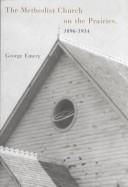| Listing 1 - 2 of 2 |
Sort by
|

ISBN: 1282859323 9786612859328 0773569219 9780773569218 0773521836 9780773521834 9781282859326 6612859326 Year: 2001 Publisher: Montreal, Que. McGill-Queen's University Press
Abstract | Keywords | Export | Availability | Bookmark
 Loading...
Loading...Choose an application
- Reference Manager
- EndNote
- RefWorks (Direct export to RefWorks)
The Methodist Church met the challenge with a centralized polity and a cross-class, gender-variegated, evolving religious culture. It relied on wealthy laymen to raise special funds, while small gifts fed its regular funds. Young bachelors from Ontario and Britain filled the pastorate, although low pay, inexperience, and poor supervision caused many to quit. Membership growth was slow due to low population density and church-resistant elements in the Methodist population (bachelors, immigrant co-religionists, and transients), and missions to non-Anglo-Saxon immigrants in Winnipeg, Edmonton, and rural Alberta spread Methodist values but gained few members. In The Methodist Church on the Prairies, 1896-1914, the first scholarly study of church history in the prairie region, George Emery uses quantitative methods and social interpretation to show that the Methodist Church was a cross-class institution with a dynamic evangelical culture, not a middle-class institution whose culture was undergoing secularization. He demonstrates that the Methodist's achievement on the prairies was impressive and compared favourably with what Presbyterians and Anglicans achieved.
Methodist Church --- Christian sects --- History. --- Prairie Provinces --- Canada --- Canada, Western --- Social conditions --- Methodist Church (Canada) --- Social conditions. --- Church history. --- Methodist Church of Canada --- Bible Christian Church (Canada) --- Primitive Methodist Church in Canada --- United Church of Canada --- RELIGION / Christianity / Methodist.
Book
ISBN: 9781783270811 9781782046202 1783270810 1782046208 Year: 2016 Volume: 33 Publisher: Woodbridge, Suffolk, UK The Boydell Press
Abstract | Keywords | Export | Availability | Bookmark
 Loading...
Loading...Choose an application
- Reference Manager
- EndNote
- RefWorks (Direct export to RefWorks)
This book shows that while the Primitive Methodist Connexion's mature social character was working-class, this did not reflect its social origins. It was never the church of the working class, the great majority of whose churchgoers went elsewhere: rather it was the church whose commitment to its emotional witness was increasingly incompatible with middle-class pretensions. Sandy Calder shows thatthe Primitive Methodist Connexion was a religious movement led by a fairly prosperous elite of middle-class preachers and lay officials appealing to a respectable working-class constituency. This reality has been obscured by the movement's self-image as a persecuted community of humble Christians, an image crafted by Hugh Bourne, and accepted by later historians, whether Methodists with a denominational agenda to promote or scholars in search of working-class radicals. Primitive Methodists exaggerated their hardships and deliberately under-played their social status and financial success. Primitive Methodism in the later nineteenth and early twentieth centuries became the victim of its own founding mythology, because the legend of a community of persecuted outcasts, concealing its actualrespectability, deterred potential recruits. SANDY CALDER graduated with a PhD in Religious Studies from the Open University and has previously worked in the private sector.
Primitive Methodist Church (Great Britain) --- History --- Historiography --- Historiography. --- 1800-1899 --- Primitive Methodist Church (Gt. Brit.) --- Methodist Church (Great Britain) --- RELIGION / Christianity / Methodist. --- 1900s. --- Christianity. --- Primitive Methodist Connexion. --- anthropology. --- church. --- methodism. --- methodist church. --- middle class. --- religion. --- socioeconomic status. --- sociology. --- twentieth century. --- working class.
| Listing 1 - 2 of 2 |
Sort by
|

 Search
Search Feedback
Feedback About UniCat
About UniCat  Help
Help News
News